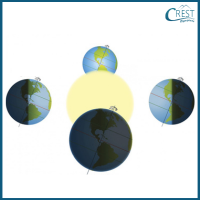1. Look at the picture below and identify the phenomenon shown in the picture.

a) Formation of daytime and nighttime
b) Movement of planets
c) Solar eclipse
d) Change in seasons
Answer: d) The image shows the Earth's revolution around the Sun, which is responsible for the change in seasons.
2 Planet X is an outer planet. It is different from other planets as it experiences extreme seasons due to its unique orbit on its side. Identify Planet X.
a) Saturn
b) Neptune
c) Uranus
d) Jupiter
Answer: c) Uranus is the planet that experiences extreme seasons due to its unique orbit on its side.
3. Name the planet that has the following characteristics:
A. It is the second closest planet to the Sun.
B. It is known as the hottest planet in our solar system due to its thick atmosphere.
C. It does not have any natural satellites or moons.
a) Venus
b) Mercury
c) Mars
d) Earth
Answer: a) Venus is the second closest planet to the Sun. It is known as the hottest planet in our solar system due to its thick atmosphere. It does not have any natural satellites or moons.
4. Why is understanding the rotation of the Earth important?
a) It helps determine the length of a year
b) It allows us to predict the occurrence of solar eclipses
c) It helps in determining what time it is in different places.
d) It assists in understanding the formation of the Moon.
Answer: c) Understanding the rotation of the Earth is important because it helps us determine what time it is in different parts of the world. As the Earth rotates, different regions move in and out of sunlight, creating the cycle of day and night.
5. Match the following.
| Column I |
Column II |
| 1. Neptune |
A) Maximum number of moons |
| 2. Jupiter |
B) Smallest planet |
| 3. Saturn |
C) Great Red Spot |
| 4. Mercury |
D) Slowest revolution speed |
a) 1:A, 2:C, 3:B, 4:D
b) 1:D, 2:C, 3:A, 4:B
c) 1:B, 2:C, 3:A, 4:D
d) 1:D, 2:A, 3:C, 4:B
Answer: b) Neptune: Slowest revolution speed
Jupiter: Great Red Spot
Saturn: Maximum number of moons
Mercury: Smallest planet


